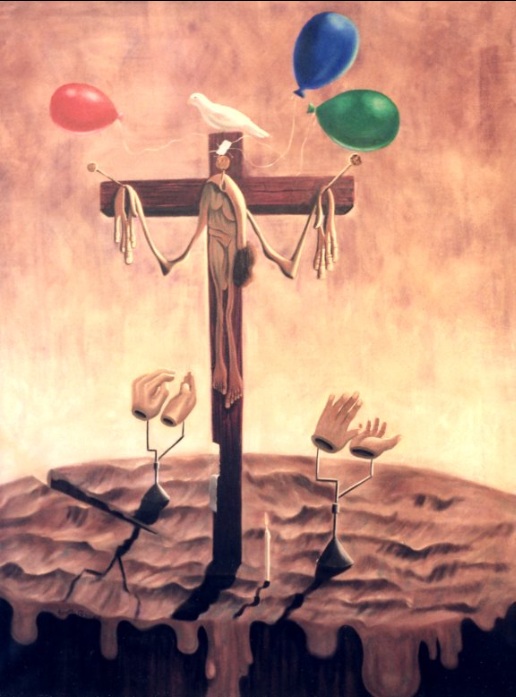The title of this painting by Anthony Falbo is a reference to Galatians 5:24: “And those who belong to Christ Jesus have crucified the flesh with its passions and desires.”
This theme rings throughout Paul’s other writings as well:
- “For we know that our old self was crucified with him so that the body of sin might be done away with, that we should no longer be slaves to sin.” (Romans 6:6)
- “. . . if by the Spirit you put to death the deeds of the body, you will live.” (Romans 8:13)
- “I have been crucified with Christ and I no longer live, but Christ lives in me.” (Galatians 2:20)
- “May I never boast except in the cross of our Lord Jesus Christ, through which the world has been crucified to me, and I to the world.” (Galatians 6:14)
These five verses seem to suggest that self-execution is a one-time thing that happens when you first come to know Christ. But when read in light of other Bible passages, we see that dying to self is actually an ongoing task.
In 1 Corinthians 15:31, Paul says, “I die daily.” Although he was referring to the physical threats on his life, Christians often receive this verse as a reminder of the importance of daily self-denial. This application, however, is more accurately gleaned from exhortative passages like Matthew 5:29-30, in which Jesus tells his listeners in graphic metaphor to cut off any part of themselves that keeps them away from God. Or Ephesians 4:22-25, in which Paul counsels the Christians in Ephesus against sins such as lying, stealing, and bitterness by telling them to put off their old sinful habits and to put on new ones.
Once you become a Christian, it doesn’t mean that all sin will automatically disappear from your life. It has to be excised, bit by bit. Then after you remove it, it often comes back, and you have to take out the scalpel again. It’s a painful process. That’s why Paul compares it to surgery. And to crucifixion.
When Christ told us to take up our cross and follow him, he didn’t want us to stop short of actually mounting it, stretching our hands across its rough wood, and putting ourselves to death there. Christians talk a lot about carrying their crosses—but what about actually dying on them? The cross is, after all, an implement for execution, not an accessory.
So how do we crucify the flesh? By living in the Spirit (Galatians 5:16), by whose power we are able to bear fruit unto righteousness. Galatians 5 contains the famous fruits of the Spirit passage, but considerably less attention is paid to the fruits of the flesh portion of the text. Paul provides his own list, but a second list is also implied by the inversion of each fruit of the Spirit into its opposite trait. By this formula, the fruits of the flesh are hatred, cheerlessness, discord or restlessness, impatience, unkindness, selfishness, disloyalty, aggression, and self-indulgence.
I must say, I struggle regularly with them all, but most of all with selfishness. I’m extremely selfish with my time, with my money, and with my self. I often think only about my own schedule, my own comfort, my own wants, my own plans. I have to crucify my selfishness daily so that I can serve others with a humble, loving heart. So that I can give like Christ gave, even if it’s inconvenient, annoying, or painful.
In Falbo’s painting Crucifying the Flesh, what looks like an inflatable body hangs completely deflated on a cross. It has been punctured by two giant nails, and now all its air is let out, revealing its hollowness. What was once firm and puffed up now sags lifelessly. Two pairs of mechanical hands applaud its demise, and three balloons likewise wave in celebration. Because through this act, there is freedom and release.
At the base of the cross, a solitary candle burns. Does it, too, signify celebration? Or mourning? Is it there to shine a light on something? To call someone home? Or does it represent something greater?—the soft, gentle presence of the Father, maybe? (In Old Testament times, God appeared to Moses in a flame, and to the Israelites in a pillar of fire.) Or the kindled faith of the person who has just crucified his flesh?
This painting represents someone who has said to sin, “You’re dead to me.” Someone who has asphyxiated his old self, and left its sorry shell. At the top of the cross, the Holy Spirit sits perched in the form of a dove, overseeing the crucifixion. It is he who empowers this act of daily self-surrender. The earth quakes and splits under the impact.
The scene reminds me of a birthday party. It almost looks as if the hilltop is actually one big birthday cake, being sliced. But why should a deathday be a birthday? Because when the flesh dies, the spirit is made alive. When you die to self for the first time, you are born again in Christ. And every subsequent death of the flesh ushers in new life and ages you in the faith.
I love this painting because it’s a visual reminder for me to give my selfish ego another poke and a pop.
What does this painting say to you?



Crucifying the flesh is a once and for all done deal. Past tense, done in repentance, never to be repeated again. The sin has stopped- that is the power of the cross, to destroy sin. Why do you still crucify sin daily? Because you have not come through your godly sorrow to begin with, and have not overcome your sin, the flesh and the devil. You are still in the pig pen wallowing in the mud. Come out of the deceptions of the great Jewish whoredom!!!!!!
James chapter 1 verse 13 When tempted, no one should say, “God is tempting me.” For God cannot be tempted by evil, nor does he tempt anyone; 14 but each person is tempted when they are dragged away by their own evil desire and enticed. 15 Then, after desire has conceived, it gives birth to sin; and sin, when it is full-grown, gives birth to death.
So yes, sin is gone, it’s destroyed, but we on our own free will, can give birth to it. Be careful.
Pingback: It Is Finished by Anthony Falbo | The Jesus Question
This is actually a birthday cake, celebrating our death and new birth.
It is a rejuvinating work. It is still working powerfully in me. Encourage one another, not shoot them done. It is a work done till the day of Christ.
Pingback: Crucified in the Flesh | Christianity 201